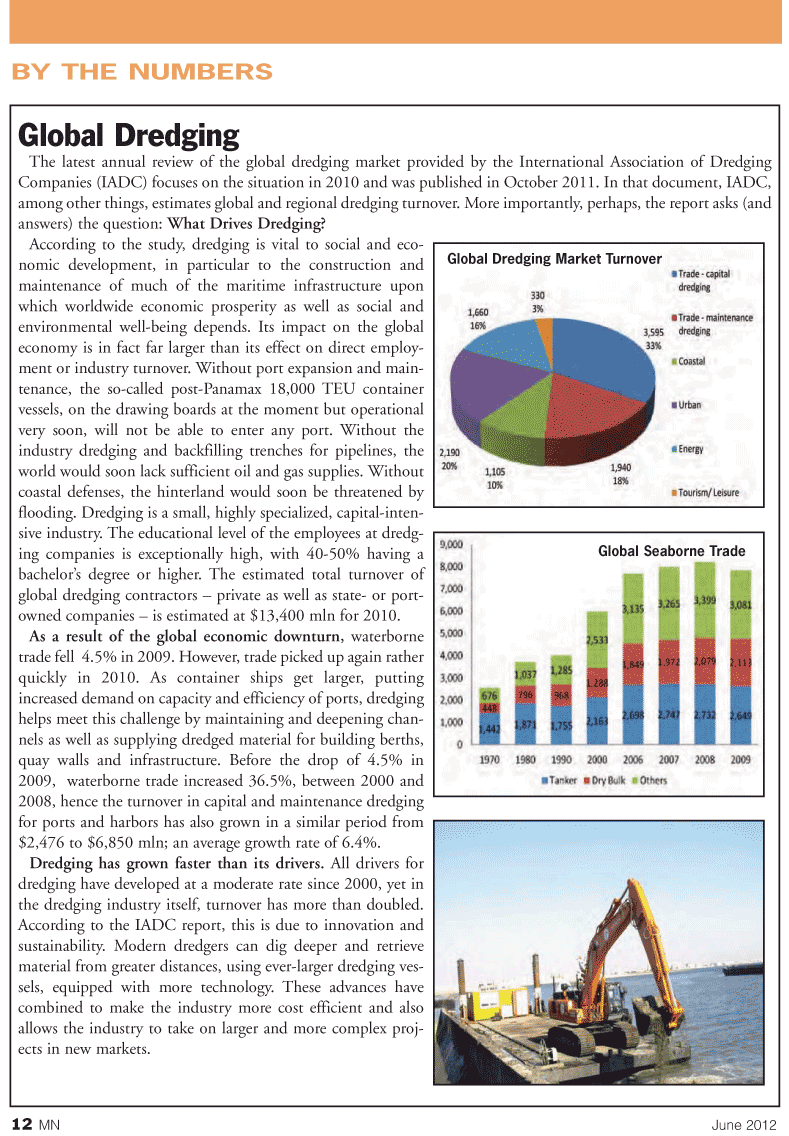
Page 12: of Marine News Magazine (June 2012)
Dredging & Marine Construction
Read this page in Pdf, Flash or Html5 edition of June 2012 Marine News Magazine
12MNJune 2012 BY THE NUMBERS Global Dredging The latest annual review of the global dredging market provided by the International Association of Dredging Companies (IADC) focuses on the situation in 2010 and was published in October 2011. In that document, IADC, among other things, estimates global and regional dredging turnover. More importantly, perhaps, the report asks (and answers) the question: What Drives Dredging? According to the study, dredging is vital to social and eco- nomic development, in particular to the construction and maintenance of much of the maritime infrastructure upon which worldwide economic prosperity as well as social and environmental well-being depends. Its impact on the global economy is in fact far larger than its effect on direct employ- ment or industry turnover. Without port expansion and main- tenance, the so-called post-Panamax 18,000 TEU container vessels, on the drawing boards at the moment but operational very soon, will not be able to enter any port. Without the industry dredging and backfilling trenches for pipelines, the world would soon lack sufficient oil and gas supplies. Without coastal defenses, the hinterland would soon be threatened by flooding. Dredging is a small, highly specialized, capital-inten- sive industry. The educational level of the employees at dredg- ing companies is exceptionally high, with 40-50% having a bachelors degree or higher. The estimated total turnover of global dredging contractors ? private as well as state- or port- owned companies ? is estimated at $13,400 mln for 2010. As a result of the global economic downturn, waterbornetrade fell 4.5% in 2009. However, trade picked up again rather quickly in 2010. As container ships get larger, putting increased demand on capacity and efficiency of ports, dredging helps meet this challenge by maintaining and deepening chan- nels as well as supplying dredged material for building berths, quay walls and infrastructure. Before the drop of 4.5% in 2009, waterborne trade increased 36.5%, between 2000 and 2008, hence the turnover in capital and maintenance dredging for ports and harbors has also grown in a similar period from $2,476 to $6,850 mln; an average growth rate of 6.4%. Dredging has grown faster than its drivers. All drivers for dredging have developed at a moderate rate since 2000, yet in the dredging industry itself, turnover has more than doubled. According to the IADC report, this is due to innovation and sustainability. Modern dredgers can dig deeper and retrieve material from greater distances, using ever-larger dredging ves- sels, equipped with more technology. These advances have combined to make the industry more cost efficient and also allows the industry to take on larger and more complex proj- ects in new markets. Global Dredging Market Turnover Global Seaborne Trade

 11
11

 13
13
